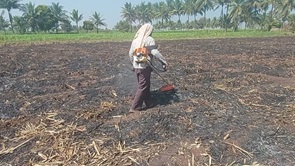Weed Management in Ratoon Crop
Ratoon by occupying approximately 50% of cane acreage in the state, plays important role in the sugar economy. Despite numerous advantages viz. no investment on land preparation and planting, early bulking, early maturity and higher sucrose content, ratoon remains a poor yielder as compared to plant crop. Among several factors responsible for poor productivity of ratoons, heavy weed infestation is an important factor. As compared to plant crop, more number of perennial weeds viz., Cynodondactylon, Sorghum halepense andCyperusrotundus, infest the ratoon crops. Crop-weed competition during initial 30 to 60 days is the most critical for weed control in sugarcane ratoon. Weeds carried from preceding crop have on upper hand in utilizing various inputs and natural resources. In sugarcane ratoon, the maximum cane yield can be obtained by three hoeing at 30, 60 and 90 days after harvest or by atrazine @ 1.5-2.0 kg/ha as pre-emergence supplemented with hoeing at 60 and 90 days after ratoon initiation or atrazine 2.0 kg/ha as pre-emergence (3 days after ratoon initiation) followed by 2, 4-D @ 1.25 kg/ha as post emergence at 90 days after ratoon initiation.
Integrated weed management:
It is essential to combine more than one method. There is an ample scope of using cultural /mechanical and chemical methods in combination so as to reduce dependence on either of the methods, which ensures the least damage to ecological balance. In planted and ratoon crop, trash mulching followed by post – emergence application of herbicides has been found effective. Combination of pre- emergence herbicides viz. atrazine or metribuzine and intercultural operations (hoeing at 60 and 90 days after planting) has been found effective and economical. Irrigation at 40-45 DAP followed by hoeing and application of atrazine 2.0 kg/ha or metribuzine @ 1.0 kg/ha and 2, 4-D @ 0.5 kg/ha were found effective 1 and economical.



